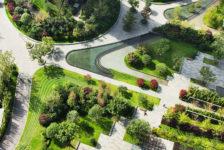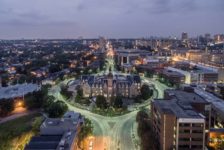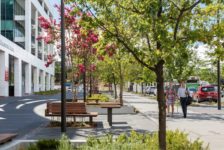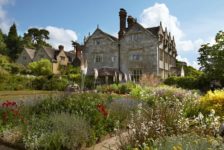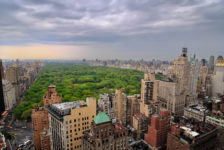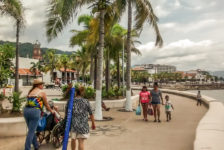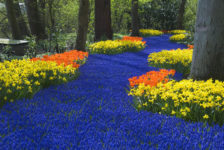10-July-2017 – Latest News Landscape Architecture July by Brett Lezon | Edition No. 2 out of 5 In this week’s Latest News in Landscape Architecture we highlight National Park and Recreation Month in the United States, feature a proposed astronomy park in Hanoi, and examine the world’s most biodiverse city. Additionally, we showcase a book about retrofitting the built environment with green infrastructure, and don’t forget our YouTube Tutorial of the Week! This week we share a resource on quirky technological advances for designers. 10 of the Best Stories in this week’s latest news in landscape architecture:
- 5 Super Cool Gadgets for Architects & Designers #3 (2017) Next Punch [YouTube Tutorial of the Week]
- Which is the World’s Most Biodiverse City?
- Moscow will Bring Back Gardens to the Center in 2017
- Regreening the Built Environment: Nature, Green Space, and Sustainability [Book Review of the Week]
- Why Do We See More Species in Tropical Forests? The Mystery May Finally Be Solved
- Urban Greenery to Get a Major Push in Mysuru
- July Highlights the Value of Local Parks, Recreation in Communities Nationwide
- First Outdoor Astronomy Park in Southeast Asia to Be Built in Hanoi
- Why We Should Be Graphically Designing Our City
- Details of Major New ‘Urban Extension’ of Newton Abbot Revealed – Including 1,275 Homes
Latest News Landscape Architecture July Edition 02
- 5 Super Cool Gadgets for Architects & Designers #3 (2017) Next Punch [YouTube Tutorial of the Week]
WATCH >>> 5 Super Cool Gadgets for Architects & Designers #3 (2017) Next Punch Throughout, this 13-minute tutorial, the presenter reviews five neat gadgets for the savviest of designers. From reMarkable, a paper tablet that replaces your sketchbooks and notebooks to Hovr, a tool that reinvents sitting—these gadgets can save time and energy. Related Article: 8 Apps for Landscape Architects and Designers
- Which is the World’s Most Biodiverse City?: The Guardian
As urbanization continues, ecosystems in many cities are grasping for survival. Since 2011, 318 types of plants, 22 types of birds, and 24 types of animals are in danger of extinction. However, São Paulo, Mexico City, Singapore, Iquitos, and many other biodiverse urban areas have made commitments to protect and preserve their natural systems. Researchers have always been interested in determining the world’s most biodiverse city, but it’s not a simple feat. For instance, some cities lack the data necessary and have varying areas within their administrative limits. Still, according to Thomas Elmqvist, editor of Urbanization, Biodiversity and Ecosystem Services and leader of the United Nation’s City and Biodiversity Outlook Project, in raw numbers Cape Town could take the top spot. For now, we know biodiversity is under threat as human population has increased by more than 30 percent since 2011. Related Article: 5 Best Ways to Increase Biodiversity in Urban Landscapes WATCH >>> Ibirapuera Park | São Paulo, Brazil
- Moscow will Bring Back Gardens to the Center in 2017: Russia Beyond the Headlines
The once extensive, green boulevard known as the Garden Ring located in central Moscow is returning to its former appearance. “The idea of tree planting and returning gardens to the Garden Ring is one of the key points of the reconstruction,” said the Strelka Design Bureau, which is responsible for the transformation. Hired for the project were sixteen well-known Russian and international firms including Latz + Partner, Villes & Paysages, and Snøhetta. Seventy-five percent of the Garden Ring is set to be completed this year. Related Article: Moscow Festival of Gardens and Flowers
- Regreening the Built Environment: Nature, Green Space, and Sustainability: Routledge [Book Review of the Week]
“Regreening the Built Environment by Michael A Richards examines the relationship between the built environment and nature and demonstrates how rethinking the role and design of infrastructure can environmentally, economically, and socially sustain the earth. The case studies will demonstrate how existing “gray” infrastructure can be retrofitted with green infrastructure and low impact development techniques. It is quite plausible that a building can be designed that actually creates greenspace or generates energy; likewise, a roadway can be a park, an alley can be a wildlife corridor, and a parking surface can be a garden.” Related Article: 10 Projects That Put Sustainability at the Forefront of Landscape Architecture
- Why Do We See More Species in Tropical Forests? The Mystery May Finally Be Solved: Smithsonian Magazine
A mystery, which dates back to 1835, may have been unraveled thanks in large part to a new study published in the journal Science. In the 1970s, Daniel Janzen and Joseph Connell hypothesized that the high plant diversity found in the tropics is due to the “presence of natural enemies that target specific species and keep population size in check and the tendency of youngsters of one species to settle far away from their parents.” That hypothesis was validated by forest ecologists Jonathan Myers and Joe LaManna after rigorously analyzing a dataset of 2.4 million trees from 3,000 species. They discovered in areas with higher numbers of adult trees, there were fewer young saplings of the same species. “It’s changed the way I think about ecology,” Myers says. “The enemy can actually have a beneficial effect in maintaining the rare species in these communities, especially in the tropics.” Related Article: How a Holistic Approach to Landscape Architecture Prevents Rainforest Damage WATCH >>> A simple idea More Top Stories in the News This Week
- Urban Greenery to Get a Major Push in Mysuru: The Hindu
- July Highlights the Value of Local Parks, Recreation in Communities Nationwide: HuffPost
- First Outdoor Astronomy Park in Southeast Asia to Be Built in Hanoi: Nhân Dân
- Why We Should Be Graphically Designing Our City: Columbia Business Times
- Details of Major New ‘Urban Extension’ of Newton Abbot Revealed – Including 1,275 Homes: Devon Live
– For all of the hottest news continue to follow us on Facebook and Twitter. Have news to share? Send to balezonasla@gmail.com News report by Brett Lezon
Published in Blog- 1 2



